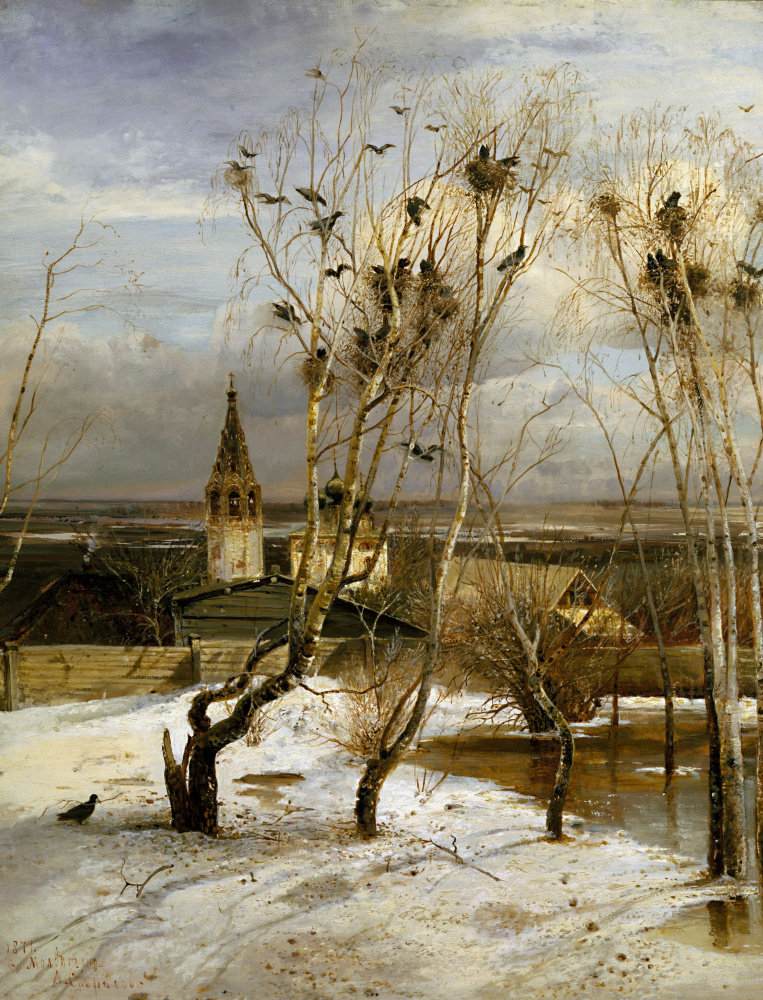log in
Enter site
Login to use Arthive functionality to the maximum
The rooks have arrived
Alexey Savrasov • Painting, 1871, 62×48.5 cm
Description of the artwork «The rooks have arrived»
The version that The Rooks Have Arrived is Savrasov's best painting is not entirely fair, or rather, generally unfair: he produced a lot of equally delightful landscapes. But it is surely the most famous one. In 1870, the artist was informed that the Moscow School of Painting, Sculpture and Architecture, in which he taught, could no longer provide him with government housing. Savrasov and his family actually stayed on the streets. He took a vacation and left for Yaroslavl for six months, acquiring commissions from Pavel Tretyakov as financial support.
In Yaroslavl in winter, after a difficult birth, the fourth child of the Savrasovs died (out of six, only two survived), his wife Sophia became seriously ill. All those adversities as if cleared the artist's eyes from the superficial, allowing his talent to manifest in full force. “The Rooks Have Arrived” became a milestone in the history of Russian painting, which established the national lyrical landscape.
Contrary to the artists initial idea, the picture turned out to show not winter, but spring. In early spring, the artist went to the village of Molvitino. His spring landscapes are neither sunny April days, nor a blooming May time. Early March was the dearest period for the artist. Savrasov was not a fan of festivity or dressiness. He shows a dilapidated old church, curved birch trees, dark earth beginning to show under the melting snow, and gray low sky with rare glimpses of blue. This is exactly what March is like in central Russia. And spring begins not with wild flowering, but with these black birds flying to the snow-covered trees, with the melting of the spongy snow.
Savrasov showed a real spring in his painting. The landscape is enlivened by the indirect human presence. The artist loved to employ the technique when he introduced a person into the picture indirectly, in this case by showing the smoke coming out of the chimney of the dilapidated house.
Savrasov was the first to show that nature has nothing unimportant. His formally everyday landscapes show the eternal and infinite existence. The rooks that arrived together with the spring build their nests on the curved birch trees. Among the birches, a small willow is ready to bloom as a symbol of revival and resurrection of life after hibernation. The walls of an old bell tower need fresh paint.
The sky is painted incredibly skillfully. The eloquent critics called Savrasov “the king of the sky.” The sky is covered with clouds, and not a slightest glimpse of sun it visible. At the same time, it is obvious that just in a moment, a sunbeam will break through the overcast sky, this is evidenced by the sharp shadows on the melting snow.
In Molvitino Savrasov drew a lot of sketches, but he finished the painting in Moscow. Having seen The Rooks, Pavel Tretyakov immediately declared that he would buy it for 500 rubles. The society of Amateur artists, where the picture was shown for the first time, did not appreciate this masterpiece. Although, at the first exhibition of the Wanderers in St. Petersburg Savrasov's Rooks created a furor.
Alyona Esaulova
In Yaroslavl in winter, after a difficult birth, the fourth child of the Savrasovs died (out of six, only two survived), his wife Sophia became seriously ill. All those adversities as if cleared the artist's eyes from the superficial, allowing his talent to manifest in full force. “The Rooks Have Arrived” became a milestone in the history of Russian painting, which established the national lyrical landscape.
Contrary to the artists initial idea, the picture turned out to show not winter, but spring. In early spring, the artist went to the village of Molvitino. His spring landscapes are neither sunny April days, nor a blooming May time. Early March was the dearest period for the artist. Savrasov was not a fan of festivity or dressiness. He shows a dilapidated old church, curved birch trees, dark earth beginning to show under the melting snow, and gray low sky with rare glimpses of blue. This is exactly what March is like in central Russia. And spring begins not with wild flowering, but with these black birds flying to the snow-covered trees, with the melting of the spongy snow.
Savrasov showed a real spring in his painting. The landscape is enlivened by the indirect human presence. The artist loved to employ the technique when he introduced a person into the picture indirectly, in this case by showing the smoke coming out of the chimney of the dilapidated house.
Savrasov was the first to show that nature has nothing unimportant. His formally everyday landscapes show the eternal and infinite existence. The rooks that arrived together with the spring build their nests on the curved birch trees. Among the birches, a small willow is ready to bloom as a symbol of revival and resurrection of life after hibernation. The walls of an old bell tower need fresh paint.
The sky is painted incredibly skillfully. The eloquent critics called Savrasov “the king of the sky.” The sky is covered with clouds, and not a slightest glimpse of sun it visible. At the same time, it is obvious that just in a moment, a sunbeam will break through the overcast sky, this is evidenced by the sharp shadows on the melting snow.
In Molvitino Savrasov drew a lot of sketches, but he finished the painting in Moscow. Having seen The Rooks, Pavel Tretyakov immediately declared that he would buy it for 500 rubles. The society of Amateur artists, where the picture was shown for the first time, did not appreciate this masterpiece. Although, at the first exhibition of the Wanderers in St. Petersburg Savrasov's Rooks created a furor.
Alyona Esaulova



